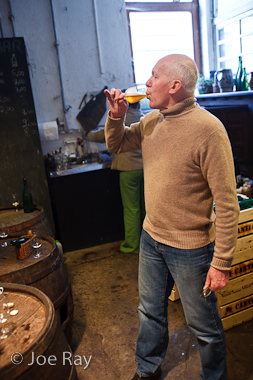Bottled Brilliance
Fall 2009 - Platinum Magazine

Traditionally renowned for its beer, brewing in Belgium is still a love affair and lambics – ‘wild’ beers dependent on the naturally occurring yeasts in the air and an expert touch – are a conviction: a reminder of a different time and a balm for our own.
“When it comes to lambic,†cautions one producer, “forget everything you know about beer.â€
The gulf between regular brewing and making lambic is vast. Certain parts of modern breweries could be mistaken for a clean room, but walk around lambic breweries like Cantillon, which calls itself “the last traditional brewery in Brusselsâ€, and you might think you’re in a hundred- year-old wine cellar.
“We’re very isolated in the world of beer,†says Jean-Pierre Van Roy whose family has run Cantillon since 1900.
Here, antique pipes leak, you hit your head on the ceiling or slip on the floor. More importantly, when you see sunlight through steam streaming from a mashing tun, breathe air that’s heady with hops, hear an old engine clank away, or simply taste a beer, you realise you’re in a cathedral and pray things don’t change for another century.
Initially, lambic production is similar to modern beer making; crushed wheat and malted barley are combined with hot water to create wort (which smells like the best hot cereal in the world and should be part of the breakfast of champions), to which aged hops are added.
Here’s the fork in the road: the hot wort is pumped into a large, shallow copper vessel called a cooling tun, where not only does the wort cool, it essentially catches a cold when wild yeasts native to the Brussels’ Senne Valley (and some say to the brewery itself) settle onto the exposed liquid.
As opposed to modern and even Trappist beers that receive specific doses of yeast cultures, lambic is ‘spontaneous fermentation’ beer, essentially at the mercy of the elements that supply the yeast – the way things were until Louis Pasteur appeared and changed brewing.
Forever changed by its exposure to the elements, the liquid is aged in oak barrels for up to three years, at which point the brew can legally be called lambic.
“I’m from Brussels and now, Brussels is a memory – the city has changed, says Van Roy. “When I met my wife and studied, there was an ‘esprit national’. When Jacques Brel sang ‘Brussels bruxellait,’ that’s a memory,†he adds, optimistically scanning his brewery. “But we’ve saved traces of that here.â€
What Van Roy was doing was saving a historical industry from extinction. In the late 1960s and early 1970s, when Van Roy took over the brewery from his father-in- law, lambics were losing ground to sweet, simple and sudsy beers.
“I changed to a policy of openness,†he says on his decision to welcome visitors, “but, the more people who came and the more I got to know, the more I realised that I wasn’t the only one who liked good beer.â€
As I visit, there’s an Italian baker learning more about natural yeast, a photographer working on a project about Cantillon’s ecologically sound production methods, a French organic wine producer and a local green guide writer. “When I started, I knocked down doors to sell my beer,†says Van Roy, “now they knock on mine.â€
A similar devotion can be found outside the city at Armand Debelder’s 3 Fonteinen brewery in Beersel. Though he buys ‘finished’ wort from nearby breweries (a common practice) and brews some of his own, Debelder is best known for his skills as a blender, pairing barrels of one- and two-year with three-year lambic to create a fizzy mixture known as gueuze.
He slides over a 2005 gueuze that’s coppery in colour and smells like the woody mustiness of the barrel room (a compliment in these parts), before giving way to the grains themselves. In the mouth, there’s cereal, acidity, bitterness and a slowly- evolving grapefruit flavour inherent in many of the best lambics. It’s bracing, with a thirst-quenching quality that gets the newly initiated over the acquired-taste hump.
“The art is in the acidity,†he says of the blender’s craft. “It’s really easy to end up with vinegar. There’s no science to this, you need to be able to taste something and see the future. I was born in beer,†he says with only a hint of a smile. “I can taste something and know what to do with it, but I can’t explain why.
Down the road, that love was also transmitted to Gert Christiaens, who grew up buying beer for his father at Beersel’s Oud Beersel brewery. When the previous owner retired, Christiaens coaxed him into teaching his craft and after a short hiatus, the 127-year-old brewery was re-opened under Christiaens’ charge.
“For years, lambic breweries were disappearing, but I couldn’t drink the [industrial] beer anymore,†he says, “I found lambics fantastic and started brewing as a hobby to protect them.â€
He stops, sights a line of barrels and smiles. “People are starting to like lambic again.â€
Nearby, the small town of Liedekerke seems an unlikely beer haven, yet it’s where Joost De Four and his wife Jessie run their restaurant, De Heeren Van Liedekerke. Here, the stairway to heaven passes down through his cellar where he keeps 350 beers and 200 vintage and Trappist brews. “Actually, I have another cellar at my house,†he later adds, “and another at my parents’ place.â€
De Four can talk you through every beer he owns and has a beer sommelier to take up the slack when he’s busy. In the kitchen, his brother Tom cooks award-winning dishes.
“Pairing food with beer may be trendy, but we’ve been doing it for 17 years,†he says. “In Brussels, people usually drink wine with food, but that’s crazy. Here, we’re chauvinists. We make the best beer in the world.”
Read the PDF here